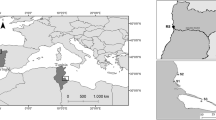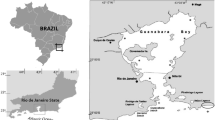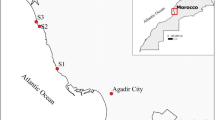Abstract
This paper aims to assess the marine environment quality along the Tunisian coasts using a statistical approach based on biomarkers response in the polychaete worms Nereis (Hediste) diversicolor. Worms were collected from six sites: Bizerta Lagoon, Gargour, Nakta, Mahres, Skhira and from Teboulba considered as a reference site. The biomarkers selected in this work were (1) the activities of cytochrome P450-dependent NADPH cytochrome c reductase (NADPH red) as phase I enzyme, (2) glutathione S-transferase as phase II enzyme and (3) the acetylcholinesterase activity as neurotoxicity marker. Oxidative stress was evaluated using catalase activity and malondialdehyde accumulation. For each biomarker, a discriminatory factor was calculated and a response index was allocated. For each site, a multi-marker pollution index was calculated as the sum of the response index of each of the five more discriminating biomarkers. The results show differences between sites compared with the reference samples. The multi-marker approach confirms that worms from Bizerta and Mahress have been submitted to highly polluted environment. Mahress shows the highest multi-marker pollution index, indicating a highly contamination status.
Similar content being viewed by others
References
Ait Alla, A., Mouneyrac, C., Durou, C., Moukrim, A., & Pellerin, J. (2006). Tolerance and biomarkers as useful tools for assessing environmental quality in the Oued Souss estuary (Bay of Agadir, Morocco). Comparative Biochemistry and Physiology C, 143, 23–29.
Amado, L. L., Da Rosa, C. E., Meirelles, L., Moraes, L., Vaz Pires, W., Pinho, G. L., et al. (2006). Biomarkers in croakers Micropogonias furnieri (Teleostei, Scianidae) from polluted and non-polluted areas from the Patos Lagoon estuary (Southern Brazil): Evidences of genotoxic and immunological effects. Marine Pollution Bulletin, 52, 199–206. doi:10.1016/j.marpolbul.2005.11.006.
Arun, S., & Subramanian, P. (2003). Cytochrome P450 and other biotransformation activity in aquatic organisms: Potential biomarkers to environmental pollution. In G. Tripathi & A. Kumar (Eds.), Potentials of living resources (pp. 459–488). New Delhi: Discovery Publishers.
Banni, M., Ben Dhiab, R., El Abed, A., & Boussetta, H. (2003). Genotoxicity, catalase and acetylcholinesterase in the biomonitoring of the Tunisian coasted areas. Bulletin of Environmental Contamination and Toxicology, 70, 167–174.
Banni, M., Jebali, J., Daubeze, M., Clerendeau, C., Guerbej, H., Narbonne, J. F., et al. (2005). Monitoring Pollution in Tunisian coasts: Application of a classification scale based on biochemical markers. Biomarkers, 10, 105–116. doi:10.1080/13547500500107497.
Banni, M., Dondero, F., Jebali, J., Guerbej, H., Boussetta, H., & Viarengo, A. (2007). Assessment of heavy metal contamination using real-time PCR analysis of mussel metallothionein mt10 and mt20 expression: A validation along the Tunisian coast. Biomarkers, 12(4), 369–383. doi:10.1080/13547500701217061.
Banni, M., Bouraoui, Z., Ghedira, J., Clearandeau, C., Jebali, J., & Boussetta, H. (2009). Seasonal variation of oxidative stress biomarkers in clams Ruditapes decussatus sampled from Tunisian coastal areas. Environmental Monitoring and Assessment doi:10.1007/s10661-008-0422-3.
Bartels-Hardege, H. D., & Zeeck, E. (1990). Reproductive behaviour of Nereis diversicolor (Annelida: Polychaeta). Marine Biology (Berlin), 106, 409–412. doi:10.1007/BF01344320.
Boujelben, B. (1998). Dosage de métaux lourds (Plomb, Cadmium, Cuivre, Zinc) dans les poissons péchés dans la région de Sfax. Doctorat en médecine vétérinaire, faculté de médecine vétérinaire de Sidi-Thabet, 79 pp.
Bradford, M. (1976). A rapid and sensitive method for the quantification of microgram quantities of protein utilizing the principle of protein-dye binding. Analytical Biochemistry, 72, 248–254. doi:10.1016/0003-2697(76)90527-3.
Buege, J. A., & Aust, S. D. (1978). Microsomal lipid peroxidation. In L. Packer (Ed.), Methods in enzymology, (Vol. 52, pp. 302–310). New York: Academic.
CGP (1996). Annuaire des statistiques des pêches en Tunisie. Tunisie: Ministère de l’agriculture.
Claiborne, A. (1985). Catalase activity. In R. A. Greenwald (Ed.), CRC handbook of methods in oxygen radical research (pp. 283–284). Florida: CRC.
Dagnino, A., Allen, J. I., Moore, M. N., Broeg, K., Canesi, L., & Viarengo, A. (2007). Development of an expert system for the integration of biomarker responses in mussels into an animal health index. Biomarkers, 12(2), 155–172. doi:10.1080/13547500601037171.
Damiens, G., His, E., Gnassia-Barelli, M., Quiniou, F., & Roméo, M. (2004). Evaluation of biomarkers in oyster larvae in natural and polluted conditions. Comparative Biochemistry and Physiology. C, 138, 121–128.
De Lafontaine, Y., Gagné, F., Blaise, C., Costan, G., Gagnon, P., & Chan, H. M. (2000). Biomarkers in zebra mussels (Dreissena polymorpha) for the assessment and monitoring of water quality of the St. Lawrence river (Canada). Aquatic Toxicology (Amsterdam, Netherlands), 50, 51–71. doi:10.1016/S0166-445X(99)00094-6.
Dellali, M., Gnassia-Barelli, M., Roméo, M., & Aissa, P. (2001). The use of acetylcholinesterase activity in Ruditapes decussatus, Mytilus galloprovincialis in the biomonitoring of Bizerta lagoon. Comparative Biochemistry and Physiology, C, 130, 227–235.
Durou, C., Poirier, L., Amiard, J. C., Budzinski, H., Gnassia-Barelli, M., Lemenach, K., et al. (2007). Biomonitoring in a clean and a multi-contaminated estuary based on biomarkers and chemical analyses in the endobenthic worm Nereis diversicolor. Environmental Pollution, 148, 445–458. doi:10.1016/j.envpol.2006.12.022.
Ellman, G. L., Courtneyk, D., Andres, V., & Featherstone, R. M. (1961). A new and rapid colorimetric determination of acetylcholinesterase activity. Biochemical Pharmacology, 7, 88–95. doi:10.1016/0006-2952(61)90145-9.
Eriksen, K. D. H., Daae, H. L., & Andersen, R. A. (1988). Evidence of presence of heavy metal-binding proteins in polychaete species. Comparative Biochemistry and Physiology, 91, 377–384.
Fauchald, K. (1977). The polychaete worms. Definitions and keys to the orders, families and genera. In Natural history museum of Los Angeles county. Science Ser. 28.
Fitzpatrick, P. J., O’Halloran, J., Sheehan, D., & Walsh, A. R. (1997). Assessment of a glutathione-S-transferase and related proteins in the gill and digestive gland of Mytilus edulis (L.) as potential organic pollution biomarkers. Biomarkers, 2, 51–56. doi:10.1080/135475097231977.
Galgani, F., & Bocquené, G. (1989). A method for routine detection of organophosphates and carbamates in sea water. Environmental Technology Letters, 10, 311–322. doi:10.1080/09593338909384746.
Habig, W. H., Pabst, M. J., & Jakoby, W. B. (1974). Glutathione S-transferases, the first step in mercapturic acid formation. The Journal of Biological Chemistry, 249(22), 7130–7139.
Hamza-Chaffai, A., & Pellerin, J. C. (2003). Health assessment of a marine bivalves Ruditapes decussatus from the Gulf of Gabés (Tunisia). Environment International, 28, 609–617. doi:10.1016/S0160-4120(02)00102-2.
Hamza-Chaffai, A., Cosson, R. P., Amiard-Triquet, C., & El Abed, A. (1995). Physico-chemical forms of storage of metals (Cd, Cu and Zn) and metallothionein like protein in fish from the Tunisian coast, ecotoxicological consequences. Comparative Biochemistry and Physiology-Part C, 111, 329–341.
Hayes, A. W. (1982). Principles and methods of toxicology (p. 612). New York, USA: Raven.
Hoareau, P., Gnassia-Barelli, M., Roméo, M., & Girard, J. P. (2001). Differential induction of GST in the clam Ruditapes decussatus. European Journal of Biochemistry, 269, 4359–4366. doi:10.1046/j.1432-1033.2002.03141.x.
Jebali, J., Banni, M., Alves de Almeida, E., & Boussetta, H. (2007). Oxidative DNA damage levels clams Ruditapes decussatus as pollution biomarkers of Tunisian marine environment. Environmental Monitoring and Assessment, 124, 195–200. doi:10.1007/s10661-006-9217-6.
Knight, J. A., Pieper, R. K., & McClellan, L. (1988). Specificity of the thiobarbituric acid reaction: Its use in studies of lipid peroxidation. Clinical Chemistry, 34, 2433–2438.
Lagadic, L., Caquet, T., & Amiard, J. C. (1997). Intérêt d’une approche multiparamétrique pour le suivi de la qualité de l’environnement. In L. Lagadic, T. Caquet, J.-C. Amiard, F. Ramade (Eds.), Biomarqueurs en écotoxicologie- aspects fondamentaux (pp. 209–240). Paris: Masson.
Leiniö, S., & Lehtonen, K. K. (2005). Seasonal variability in biomarkers in the bivalves Mytilus edulis and Macoma balthica from the northern Baltic Sea. Comparative Biochemistry and Physiology, (Part C), 140, 408–421.
Livingstone, D. R. (1991). Organic xenobiotic metabolism in marine invertebrates. Advanced Comparative Environmental and Physiology, 7, 145–187.
Lucan-Bouché, M. L., Biagianti-Risbourg, S., Arsac, F., & Vernet, G. (1999). An original decontamination process developed by aquatic oligochaete Tubifex tubifex exposed to copper and lead. Aquatic Toxicology (Amsterdam, Netherlands), 45, 9–17. doi:10.1016/S0166-445X(98)00091-5.
Marcano, L., Nusetti, O., Rodrıguez-Grau, J., & Vilas, J. (1996). Uptake and depuration of copper and zinc in relation to metal-binding protein in the polychaete Eurythoe complanata. Comparative Biochemistry and Physiology, 114, 179–184.
Matthiessen, P., & Law, R. J. (2002). Contaminants and their effects on estuarine and coastal organisms in the United Kingdom in the late twentieth century. Environmental Pollution, 120, 739–757.
Narbonne, J. F., Daubeze, M., Clerandeau, C., & Garrigues, P. (1999). Scale of classification based on biochemical markers in mussels: Application to pollution monitoring in European coasts. Biomarkers, 4, 415–424.
PNUE/COI/AIEA/FAO (1994). Programme de surveillance continue des contaminants utilisant des organismes marins. Assurance de la qualité et bonnes pratiques de laboratoire. Méthodes de référence pour les études de la pollution marine no. 57, PNUE, 25 pp.
Saiz-Salinas, J., & Gonzalez-Oreja, J. A. (2000). Stress in estuarine communities: Lessons from the highly-impacted Bilbao estuary (Spain). Journal of Aquatic Ecosystem Stress and Recovery, 7, 43–55. doi:10.1023/A:1009919429985.
Scaps, P. (2002). A review of the biology, ecology and potential use of the common ragworm Hediste diversicolor (O.F. Muller) (Annelida: Polychaeta). Hydrobiologia, 470, 203–218. doi:10.1023/A:1015681605656.
Scaps, P., & Borot, O. (2000). Acetylcholinesterase activity of the polychaete Nereis diversicolor: Effects of temperature and salinity. Comparative Biochemistry and Physiology, (Part C), 125, 377–383.
Smaoui-Damak, W., Hamza-Chaffaia, A., Bebianno, M.-J., & Amiard, J.-C. (2004). Variation of metallothioneins in gills of the clam Ruditapes decussates from the Gulf of Gabes (Tunisia). Comparative Biochemistry and Physiology, (Part C), 139, 181–188.
Vidal, M. L., Bassères, A., & Narbonne, J.-F. (2002). Seasonal variations of pollution biomarkers in two populations of Corbicula fluminea (Muller). Comparative Biochemistry and Physiology, (Part C), 131, 133–151.
Author information
Authors and Affiliations
Corresponding authors
Rights and permissions
About this article
Cite this article
Bouraoui, Z., Banni, M., Chouba, L. et al. Monitoring pollution in Tunisian coasts using a scale of classification based on biochemical markers in worms Nereis (Hediste) diversicolor . Environ Monit Assess 164, 691–700 (2010). https://doi.org/10.1007/s10661-009-0921-x
Received:
Accepted:
Published:
Issue Date:
DOI: https://doi.org/10.1007/s10661-009-0921-x




